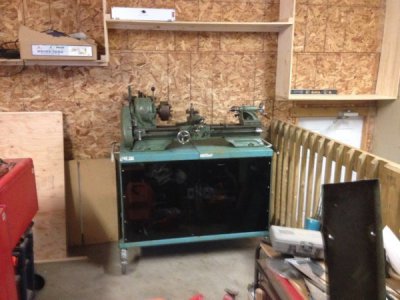- Joined
- Oct 17, 2018
- Messages
- 966
Yes, we have a database in the Atlas/Craftsman/AA section of Downloads that lists 400+ Atlas or Craftsman lathes (from 1932 through early 1981, Atlas [now called Clausing] built all of the better lathes that Sears sold) plus mills, shapers and a few drill presses and band saws. But access to Downloads requires being a donor (any level from $10 per year up) because the necessary storage space is not free. However, S/N 022526 would have been made around January of 1941. Unfortunately, after buying Clausing and later renaming the company to Clausing, Atlas moved several times and all of their production history records were either lost or destroyed. So to approximately date one of them, we have to get by with the few that have had the bearing dates reported. At least, that gives the earliest date one could have been made.
In evaluating the wear (this applies to any machine, not just Atlas), there are two places to check, bed wear and lead screw wear. Many other places will also wear, but if these two are little worn or badly worn, so will be all of the other places. The two are bed wear and lead screw wear.
To measure bed wear, you will need a 0-1" and a 1-2" micrometer. First inspect the under surface of the front way near the right end of the bed for evidence of varnish buildup. Significant varnish buildup will be about the color of dark caramel. If present, first remove with a scrub pad and acetone (wear surgical gloves while doing this). Then measure the thickness of the front of the front way within a few inches of the right end of the bed. This should have originally been 0.375" +/- about 0.0005".Repeat the measurement at several points along the bed up to near the front of the chuck. The limit is probably about 0.010". Repeat with the rear of the front way, and the front and rear of the rear way. Then measure the width of the front and rear ways near the tailstock end of the bed and at several points between there and up near the chuck..
In Downloads in the Lathe Maintenance & Repair folder is a screed on the effect of tailstock height error on part diameter versus the nominal part diameter. The figures given are directly applicable to bed wear figures. Note that the effect of 0.010" vertical error on diameter error is negligible for diameters over about 1/2". Unfortunately, the effect of wear on the rear of the rear way is an error of double the wear.
To evaluate leadscrew wear, you need a dial indicator set up to measure movement of the carriage toward and away from the headstock. Move the tailstock and the carriage to near the right end of the bed and engage the half nuts (AKA split nuts). rock the carriage traverse handwheel back and fourth and note the difference between the two indicator readings. Disengage the half nuts and crack the carriage toward the headstock until the cutter is about an inch from being hit by the chuck jaws. Engage the half nuts, set up the indicator, and again note the difference in indicator readings as you rock the carriage back and forth. The difference between the two differences is the lead screw wear.
I'll add to this tomorrow.
Thanks so much for the info, I really appreciate it. I will use this when I look at the machines.
What is the tolerance for lead screw wear? What is an acceptable difference between the two differences?

